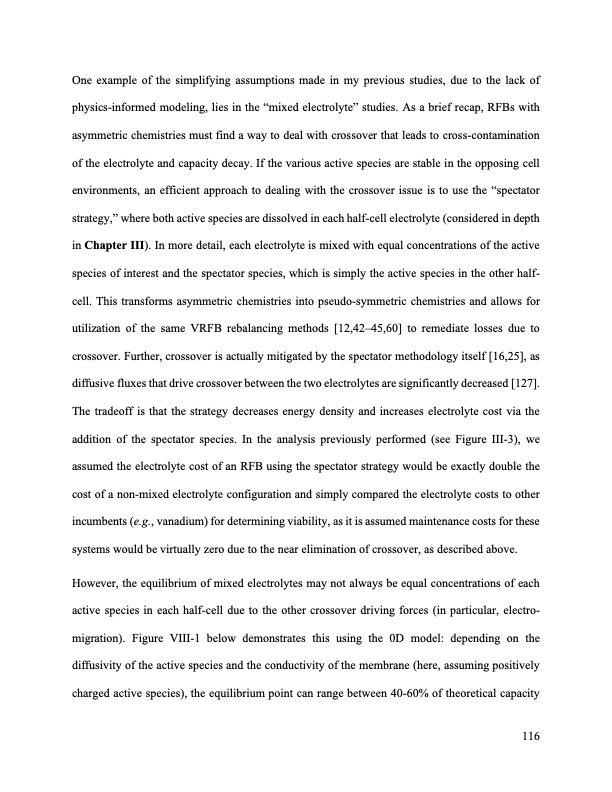
PDF Publication Title:
Text from PDF Page: 116
One example of the simplifying assumptions made in my previous studies, due to the lack of physics-informed modeling, lies in the “mixed electrolyte” studies. As a brief recap, RFBs with asymmetric chemistries must find a way to deal with crossover that leads to cross-contamination of the electrolyte and capacity decay. If the various active species are stable in the opposing cell environments, an efficient approach to dealing with the crossover issue is to use the “spectator strategy,” where both active species are dissolved in each half-cell electrolyte (considered in depth in Chapter III). In more detail, each electrolyte is mixed with equal concentrations of the active species of interest and the spectator species, which is simply the active species in the other half- cell. This transforms asymmetric chemistries into pseudo-symmetric chemistries and allows for utilization of the same VRFB rebalancing methods [12,42–45,60] to remediate losses due to crossover. Further, crossover is actually mitigated by the spectator methodology itself [16,25], as diffusive fluxes that drive crossover between the two electrolytes are significantly decreased [127]. The tradeoff is that the strategy decreases energy density and increases electrolyte cost via the addition of the spectator species. In the analysis previously performed (see Figure III-3), we assumed the electrolyte cost of an RFB using the spectator strategy would be exactly double the cost of a non-mixed electrolyte configuration and simply compared the electrolyte costs to other incumbents (e.g., vanadium) for determining viability, as it is assumed maintenance costs for these systems would be virtually zero due to the near elimination of crossover, as described above. However, the equilibrium of mixed electrolytes may not always be equal concentrations of each active species in each half-cell due to the other crossover driving forces (in particular, electro- migration). Figure VIII-1 below demonstrates this using the 0D model: depending on the diffusivity of the active species and the conductivity of the membrane (here, assuming positively charged active species), the equilibrium point can range between 40-60% of theoretical capacity 116PDF Image | Bringing Redox Flow Batteries to the Grid

PDF Search Title:
Bringing Redox Flow Batteries to the GridOriginal File Name Searched:
Rodby-krodby-phd-chemE-2022-thesis.pdfDIY PDF Search: Google It | Yahoo | Bing
Salgenx Redox Flow Battery Technology: Salt water flow battery technology with low cost and great energy density that can be used for power storage and thermal storage. Let us de-risk your production using our license. Our aqueous flow battery is less cost than Tesla Megapack and available faster. Redox flow battery. No membrane needed like with Vanadium, or Bromine. Salgenx flow battery
| CONTACT TEL: 608-238-6001 Email: greg@salgenx.com | RSS | AMP |